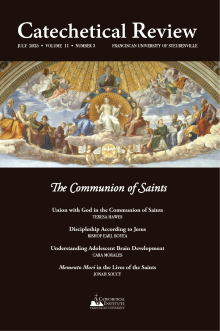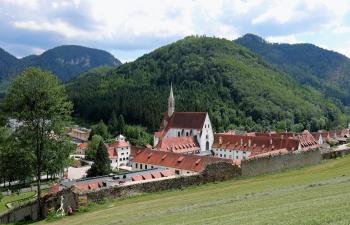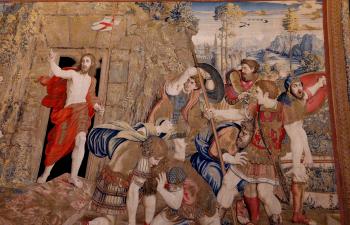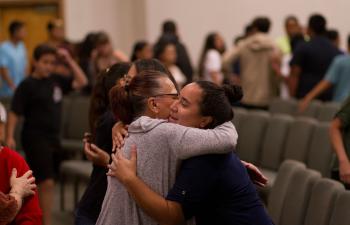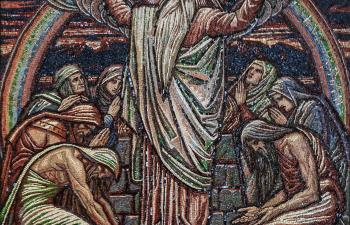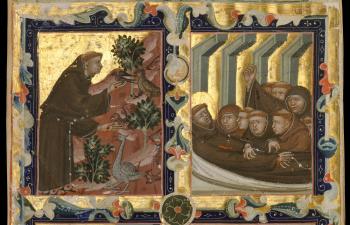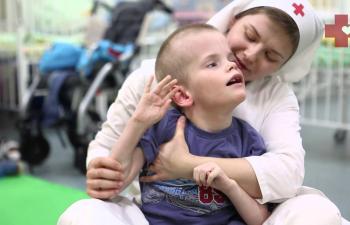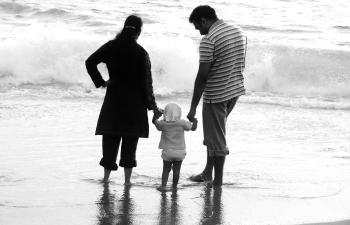 What do you think when you read the word “saint”? Do you imagine an icon of a placid martyr, like Ignatius of Antioch crawling with lions? Perhaps you think of a saint from your own living memory, like Pope St. John Paul II or St. Teresa of Calcutta. Or maybe you think of a living person you know who embodies sanctity and who might even one day have a place in the Roman canon. Words like “sin,” “failure,” and “redemption,” however, are probably not the first to come to mind when most of us think of the saints.
What do you think when you read the word “saint”? Do you imagine an icon of a placid martyr, like Ignatius of Antioch crawling with lions? Perhaps you think of a saint from your own living memory, like Pope St. John Paul II or St. Teresa of Calcutta. Or maybe you think of a living person you know who embodies sanctity and who might even one day have a place in the Roman canon. Words like “sin,” “failure,” and “redemption,” however, are probably not the first to come to mind when most of us think of the saints.
This is understandable, and it has been affected by historical circumstances that have shaped our writing about the saints through the centuries. We need and want good examples, and the stories of saints we have grown accustomed to are mostly positive tales of their virtue and accomplishments.
Let’s say your child has aspirations of becoming a great soccer player. What do you do? You go on YouTube and find highlight videos of Lionel Messi dribbling and shooting and say, “Look, if you practice, you could do that.” I know because I have done this. We generally don’t watch highlight reels of mistakes (lowlights?) or long, slow videos of improvement.
For a long time, this is what we have done with the majority of our presentations of the saints, as well. We love to talk about their incredible sanctity (“St. John Vianney only slept two hours a night because he heard so many confessions!”) or we focus on the saints who don’t have very visible stories of sin or conversion.[1] I have a deep love for saints such as Thérèse of Lisieux and John Paul the Great, but I sometimes find treatments of their lives difficult to relate to, as these stories give the impression that they never struggled with sin in the way that I do.
St. Monica, the mother of St. Augustine of Hippo, is a good example of this treatment. As a scholar of the early Church who has read St. Augustine’s Confessions numerous times, I have slowly become aware of the flat and incomplete treatment we often give to St. Monica by focusing only on the one great aspect of sanctity for which she is most famous: intercession for her wayward son. It is understandable that we focus on this, particularly when there are people in our families who are far from God. Intercession for Augustine is St. Monica’s most prominent activity in the Confessions itself, as Augustine wanted to clearly depict the means that God used to bring him to conversion.
However, Monica is a more complex figure than simply the “Mother of Tears” who prayed her son into the Church. Long before the blessed death of his mother related by Augustine in book 9 of the Confessions, he gives us several glimpses into parts of Monica’s life that needed redemption. By examining three of these and seeing how God’s grace was operative in each situation, my hope is to demonstrate how saints like Monica can be examples to us of the redemptive power of God in normal circumstances and not just examples of truly exceptional sanctity.[2] I will examine them in the order in which Augustine describes them in the Confessions, which is not chronological.
The rest of this online article is available for current Guild members.
[1] There are a couple of notable exceptions to this, the most famous one being St. Augustine. St. Ignatius of Loyola and St. Francis of Assisi are partial exceptions, with their famous moments of conversion, but we hardly talk about the sins they committed before they turned to God. For many of the Church Fathers who converted as adults, there was a general reticence to even talk about their lives before baptism. See, for example, Pontius the Deacon’s Vita of St. Cyprian of Carthage: “At what point, then, shall I begin—from what direction shall I approach the description of his goodness, except from the beginning of his faith and from his heavenly birth? Inasmuch as the doings of a man of God should not be reckoned from any point except from the time that he was born of God.” Pontius the Deacon, Life and Passion of St. Cyprian, trans. Robert Ernest Wallis, in Ante-Nicene Fathers, vol. 5, ed. Alexander Roberts, James Donaldson, and A. Cleveland Coxe (Christian Literature Publishing, 1886), 2; revised and edited for New Advent by Kevin Knight, http://www.newadvent.org/fathers/0505.htm.
[2] One significant story about Monica that I am leaving out is Augustine’s description in book 9 of how she endured physical abuse and marital infidelity on the part of her husband—and advised other women to do the same because of their position as slaves and property of their husbands. Augustine depicts this positively, saying that she understood the subordination due to a husband and that she did it all in hopes of converting her husband, Patricius, by example, which she did toward the end of his life. The complexity and cultural mores involved here would require an entirely separate treatment.
[3] In Carthage in the middle of the third century, St. Cyprian wrote to one Fidus, who was arguing that baptism should wait for the eighth day of life, to match the ancient custom of circumcision. Cyprian sent Fidus the conclusion of a local synod of bishops that infants should be baptized as soon as possible, because “we must do everything we possibly can to prevent the destruction of any soul.” St. Cyprian of Carthage, letter 64, in The Letters of St. Cyprian of Carthage, trans. G. W. Clarke, Ancient Christian Writers 46 (Newman Press, 1986), 3:2.1. Augustine himself vigorously defended the practice of infant baptism against heretics in his work On Baptism Against the Donatists. In book 4 of that work, Augustine writes that infant baptism is “an invariable custom” that predates even councils and “is rightly held to have been handed down by apostolical authority.” St. Augustine, On Baptism Against the Donatists, trans. J. R. King, Nicene and Post-Nicene Fathers, 1st ser., vol. 4, ed. Philip Schaff (Christian Literature Publishing, 1887), 4:4.24; revised and edited for New Advent by Kevin Knight, http://www.newadvent.org/fathers/14084.htm.
[4] St. Augustine, The Confessions, trans. Maria Boulding, ed. John Rotelle, The Works of St. Augustine 1, no. 1 (New City Press, 1997), I.11.17.
[5] Augustine, Confessions, I.11.17
[6] Augustine, Confessions, I.11.18, (emphasis added). Particularly when describing his boyhood, when there is something negative that could be seen to include his mother, Augustine tends to blame his “parents” or “family” rather than directly implicating her.
[7] Augustine, Confessions, I.9.14; I.10.16.
[8] Augustine, Confessions, VI.2.2.
[9] Augustine, Confessions, VI.2.2.
[10] Augustine, Confessions, VI.2.2.
[11] Augustine does not explain why this is; presumably, in North Africa, the Eucharist could not be celebrated because the devoted were breaking the fast by feasting on normal food and drink.
[12] Augustine, Confessions, IX.8.18.
[13] Augustine, Confessions, IX.8.17.
[14] Augustine, Confessions, IX.8.18.
Art Credit: Saints Augustine and Monica by Ary Scheffer, Wikimedia Commons.
This article originally appeared on pages 66 - 73 of the print edition.
This article is from The Catechetical Review (Online Edition ISSN 2379-6324) and may be copied for catechetical purposes only. It may not be reprinted in another published work without the permission of The Catechetical Review by contacting [email protected]

